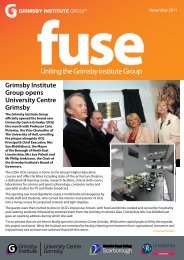Journal of Research & Scholarly Output 2006 - Grimsby Institute of ...
Journal of Research & Scholarly Output 2006 - Grimsby Institute of ...
Journal of Research & Scholarly Output 2006 - Grimsby Institute of ...
You also want an ePaper? Increase the reach of your titles
YUMPU automatically turns print PDFs into web optimized ePapers that Google loves.
‘Not without reason has antiquity allowed<br />
the stories <strong>of</strong> saints to be painted in holy<br />
places. And we indeed entirely praise thee<br />
for not allowing them to be adored, but we<br />
blame thee for breaking them. For it is one<br />
thing to adore an image, it is quite another<br />
thing to learn from the appearance <strong>of</strong> a<br />
picture what we must adore. What books are<br />
to those who can read, that is a picture to<br />
the ignorant who look at it; in a picture even<br />
the unlearned may see what example they<br />
should follow; in a picture they who know no<br />
letters may yet read. Hence, for barbarians<br />
especially a picture takes the place <strong>of</strong> a<br />
book’<br />
The Veneration <strong>of</strong> Images, Catholic<br />
Encyclopaedia(4)<br />
Medieval tomb sculpture, Jerpoint Abbey,<br />
Ireland, c.1500 (a)<br />
This clearly indicates that religious<br />
iconography (usually without supporting<br />
text) was being produced with the sole<br />
intention <strong>of</strong> presenting narratives in a<br />
pictorial form as a substitute for written text,<br />
which was firmly in the hands <strong>of</strong> the learned<br />
within the hierarchy <strong>of</strong> the Catholic Church.<br />
Imagery was the key to both educating and<br />
controlling the masses –the people were<br />
given information orally or through the<br />
presentation <strong>of</strong> graphic (<strong>of</strong>ten sequential)<br />
images across Europe up until and beyond<br />
the Reformation, indicating that most<br />
Europeans would have the ability to<br />
understand the messages being presented<br />
to them by employing deconstructive skills<br />
very similar to those used today in the<br />
reading <strong>of</strong> a sequential art text. Theorists<br />
such as Andrew Greeley believe that the<br />
contemporary Catholic reader <strong>of</strong> texts is<br />
quite different to a non-Catholic reader in<br />
that their imaginations are based on<br />
analogies, a ‘metaphorical narrative’ as<br />
defined by Greeley in his book ‘The Catholic<br />
Myth – The Behaviour and Beliefs <strong>of</strong><br />
American Catholics’ (5) and directly<br />
represented by symbolic representations<br />
during the administration <strong>of</strong> the Sacraments<br />
and presentation <strong>of</strong> religious belief within<br />
the Catholic Church. It is reasonable to<br />
assume that this ‘metaphorical narrative’<br />
has been generated, fostered and<br />
maintained through the use <strong>of</strong> religious<br />
imagery throughout the centuries – and, in<br />
particular, imagery that shows a series <strong>of</strong><br />
events in order to reinforce the teachings <strong>of</strong><br />
the Church. This may provide some<br />
reinforcement as to why mainland Europe<br />
continues to enjoy sequential art and<br />
embrace it as an art form, and why the<br />
events <strong>of</strong> the Reformation are so vital in the<br />
shaping <strong>of</strong> attitudes towards sequential art<br />
which is irrefutably image-based.<br />
Stained Glass window, Collegiate Church <strong>of</strong><br />
St. Nicholas, Gallway, 1320 (b)<br />
FOCUS Page Page 75

















